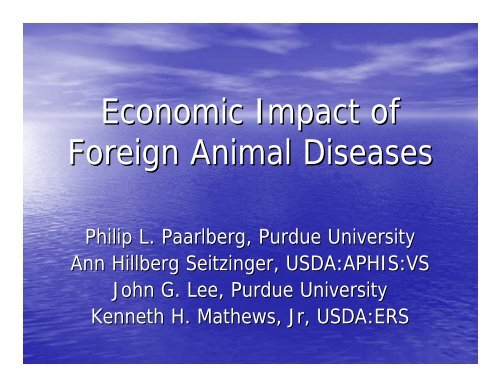Economic Impact of Foreign Animal Diseases - Farm Foundation
Economic Impact of Foreign Animal Diseases - Farm Foundation
Economic Impact of Foreign Animal Diseases - Farm Foundation
You also want an ePaper? Increase the reach of your titles
YUMPU automatically turns print PDFs into web optimized ePapers that Google loves.
<strong>Economic</strong> <strong>Impact</strong> <strong>of</strong><br />
<strong>Foreign</strong> <strong>Animal</strong> <strong>Diseases</strong><br />
Philip L. Paarlberg, Purdue University<br />
Ann Hillberg Seitzinger, Seitzinger,<br />
USDA:APHIS:VS<br />
John G. Lee, Purdue University<br />
Kenneth H. Mathews, Jr, Jr,<br />
USDA:ERS
Introduction<br />
• Objective is to estimate the economic<br />
impacts <strong>of</strong> select livestock disease<br />
outbreaks and control strategies<br />
• Method integrates animal disease<br />
simulation models with a quarterly<br />
agricultural sector model
Foot and Mouth Disease Scenario<br />
• Outbreak initiated in four small Midwest swine<br />
operations<br />
• Alternative control strategies<br />
• Destruction <strong>of</strong> direct contacts with 50% probability<br />
<strong>of</strong> successful traceback<br />
• Destruction <strong>of</strong> direct and indirect contacts with 50%<br />
probability <strong>of</strong> successful traceback<br />
• Ring destruction around infected operations <strong>of</strong> 1 km<br />
• Export embargo for beef, pork, lamb meat,<br />
cattle, swine, lambs, and sheep extend 3<br />
months beyond outbreak
Cattle Price<br />
$/cwt<br />
120<br />
100<br />
80<br />
60<br />
40<br />
20<br />
0<br />
Q1 2001<br />
Q2<br />
Q3<br />
Q4<br />
Q1 2002<br />
Q2<br />
Q3<br />
Q4<br />
Q1 2003<br />
Q2<br />
Q3<br />
Q4<br />
Q1 2004<br />
Q2<br />
Q3<br />
Q4<br />
FMD Base FMD Mean FMD High
$/cw<br />
Retail Beef Price<br />
450<br />
400<br />
350<br />
300<br />
250<br />
200<br />
150<br />
100<br />
50<br />
0<br />
Q1 2001<br />
Q2<br />
Q3<br />
Q4<br />
Q1 2002<br />
Q2<br />
Q3<br />
Q4<br />
Q1 2003<br />
Quarter<br />
FMD Base FMD Mean FMD High<br />
Q2<br />
Q3<br />
Q4<br />
Q1 2004<br />
Q2<br />
Q3<br />
Q4
FMD – Change in Net Returns to<br />
Capital and Management<br />
Crops<br />
Swine Processing<br />
Swine<br />
Beef Processing<br />
Beef Cattle<br />
-100 -80 -60 -40 -20 0 20<br />
Percent<br />
Mean Outbreak High Outbreak
FMD – Change in Net Returns to<br />
Capital and Management<br />
Crops<br />
Swine Processing<br />
Swine<br />
Beef Processing<br />
Beef Cattle<br />
-4000 -3000 -2000 -1000 0 1000<br />
Million Dollars<br />
Mean Outbreak High Outbreak
Classical Swine Fever Scenario<br />
• Patterned after Netherlands 1997<br />
outbreak<br />
• 11 million hogs destroyed<br />
• 5 quarter outbreak<br />
• Export embargo on all live hogs
Mil Dollars<br />
CSF - Net Returns to Capital and<br />
Management for Hogs<br />
2500<br />
2000<br />
1500<br />
1000<br />
500<br />
0<br />
Q1 2001<br />
Q2<br />
Q3<br />
Q4<br />
Q1 2002<br />
Q2<br />
Q3<br />
Q4<br />
Q1 2003<br />
Q2<br />
Base CSF<br />
Q3<br />
Q4<br />
Q1 2004<br />
Q2<br />
Q3<br />
Q4
Mi Dollars<br />
CSF – Net Returns to Capital and<br />
Management for Pork<br />
1200<br />
1000<br />
800<br />
600<br />
400<br />
200<br />
0<br />
-200<br />
-400<br />
-600<br />
Q1 2001<br />
Q2<br />
Q3<br />
Q4<br />
Q1 2002<br />
Q2<br />
Q3<br />
Q4<br />
Q1 2003<br />
Base CSF<br />
Q2<br />
Q3<br />
Q4<br />
Q1 2004<br />
Q2<br />
Q3<br />
Q4
Highly Pathogenic Avian Influenza<br />
Scenario<br />
• 3 percent production loss for poultrymeat and<br />
eggs<br />
• 89 percent reduction in poultrymeat exports<br />
• Withdrawal <strong>of</strong> poultrymeat and egg consumers<br />
– Q1, 20 percent<br />
– Q2, 10 percent<br />
– Q3, 5 percent
AI – Net Returns to Capital and<br />
Management for Poultrymeat<br />
Mil Dollars<br />
1200<br />
1000<br />
800<br />
600<br />
400<br />
200<br />
0<br />
Q1 2001<br />
Q2<br />
Q3<br />
Q4<br />
Q1 2002<br />
Q2<br />
Q3<br />
Q4<br />
Q1 2003<br />
Base AI<br />
Q2<br />
Q3<br />
Q4<br />
Q1 2004<br />
Q2<br />
Q3<br />
Q4
AI – Poultrymeat Producer Returns<br />
and Consumer Surplus<br />
Loss in Returns to Capital and<br />
Management<br />
Consumer Surplus Gain for<br />
Continuing Consumers<br />
Consumer Surplus Loss for<br />
Nonconsuming<br />
Total Consumer Surplus Loss<br />
-$717.4 $717.4 million (-7.6 ( 7.6 percent)<br />
+$152.8 million<br />
-$711.9 $711.9 million<br />
-$559.1 $559.1 million (-2.5 ( 2.5 percent)
Conclusions<br />
• FMD results highlight the role <strong>of</strong> outbreak<br />
length<br />
• CSF results show the long run impacts <strong>of</strong><br />
loss <strong>of</strong> breeding inventory<br />
• AI results pick up the consumer response<br />
in addition to loss <strong>of</strong> exports
















